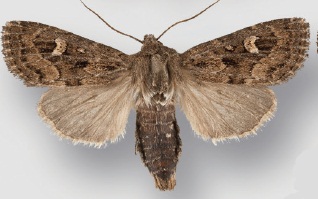
Pyramidobela quinquecristata is a moth in the family Oecophoridae. It is found in the mountains around the margins of the Great Basin in North America.
Pyramidobela agyrtodes is a moth in the family Oecophoridae. It is found from in southern North America from extreme western Texas to southern Chihuahua and Nuevo León.
Ethmia umbrimarginella is a moth in the family Depressariidae.
Ethmia coquillettella is a moth in the family Depressariidae. It is found in North America along the southern and inner central coast range of California and has also been recorded from interior British Columbia.
Ethmia brevistriga is a moth in the family Depressariidae. It is in California, United States.
Ethmia albistrigella is a moth in the family Depressariidae. It is found in North America from southern British Columbia southward in the Rocky Mountains to south-western Colorado and into the Wasatch Range in northern Utah. On the Pacific coast it ranges through western Washington and Oregon into the mountains of California. Subspecies icariella is an Arctic-Alpine zone race which has only been recorded from California.
Ethmia albitogata is a moth in the family Depressariidae. It is found in central California.
Ethmia charybdis is a moth in the family Depressariidae. It is found in California, United States.
Ethmia nadia is a moth in the family Depressariidae. It is found in California.
Ethmia timberlakei is a moth in the family Depressariidae. It is found in California, United States.
Ethmia semitenebrella is a moth in the family Depressariidae. It is found in North America from Colorado, Utah, New Mexico and Nuevo León in Mexico to Arizona and southern and eastern California.
Ethmia discostrigella, the mountain-mahogany moth, is a moth in the family Depressariidae. It is found from the western United States, south into Mexico.

Ethmia monticola, the gray ethmia moth, is a moth in the family Depressariidae. It is found in North America from British Columbia and Alberta to California and Arizona, east at least to North Dakota and Colorado.

Ethmia ungulatella is a moth in the family Depressariidae. It is found from Panama north through Central America to eastern Mexico. The habitat consists of dry forests and rain forests.
Ethmia gelidella is a moth in the family Depressariidae. It is found in Jamaica.
Ethmia semiombra is a moth in the family Depressariidae. It is found in Texas and Mexico.
Ethmia albicostella is a moth in the family Depressariidae. It is a widespread species in the Rocky Mountains and Sierra Madre Occidental of Mexico, ranging from southern Manitoba, Saskatchewan, and Montana through the southern Rocky Mountain states at moderately high elevations and mountains of western Mexico at least south to Durango.
Ethmia hodgesella is a moth in the family Depressariidae. It is found in the United States in Texas, Arizona, and California, extending along the two sides of the central cordillera of Mexico.

Drasteria parallela is a moth in the family Erebidae. It is found in the Cascade Mountains of Washington, the Klamath and Siskiyou Mountains of south-western Oregon and the northern Sierra Nevada in California. The habitat consists of exposed ridges in forests at middle elevations.

Resapamea diluvius is a moth in the family Noctuidae. It occurs in the Columbia Basin in Washington and northern Oregon. It is possibly also present in the dunes of northern Nevada and the northern Great Plains.





